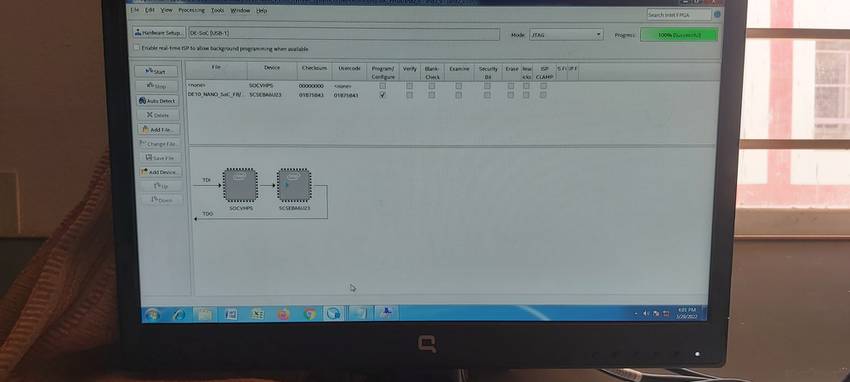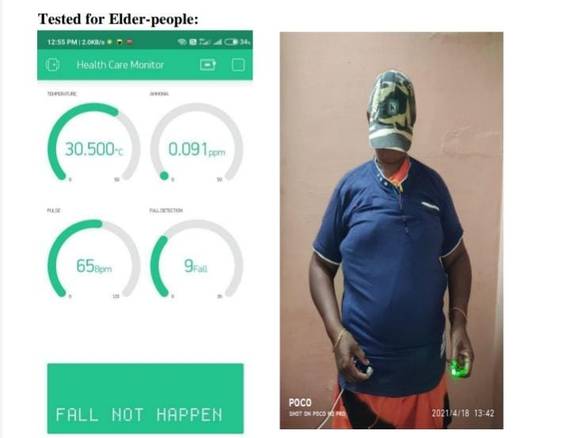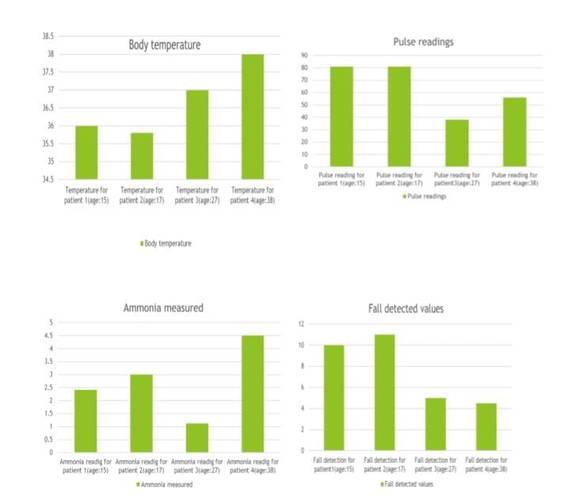
A comfortable health monitoring unit which is wearable for
patients is presented .The unit is based on a wearable interface
implemented by temperature sensor, pulse detector, ammonia gas
sensor and accelerometer.
This unit works with existing devices including above mentioned
sensors. They are attached to patients cloth that transmits data in
wireless medium to central monitor.
To continuously monitor the health care aspects such as body
temperature, odour of NH3 gas , activity movement and location
of bed ridden patients.
Demo Video
Project Proposal
1. High-level project introduction and performance expectation
SMART HEALTH CARE MONITORING UNIT FOR BEDRIDDEN PATIENTS
Giving care & health assistance to the bed ridden patients at critical stages with advanced medical facilities have become one amongst the foremost problems in modern hectic world. During this day and age, where time is efficacious, individuals, particularly the labor, bear an oversized portion of the day transporting between different assignments and can normally disregard their wellbeing and wellness. Indeed, even a basic meeting with a speciality center can require some tests set for determination & solution, lastly treatment, which might take a large amount of your time. Besides this, numerous patients simply attend a centre when they are experiencing a real sickness. Consequently, numerous individuals are searching for an alternate, for instance : a gadget that may be worn on the body, which might not just consistently screen the client's wellbeing in constant yet additionally give opportune experiences on different wellbeing boundaries to the client even as their doctor.
This project is meant so as to assist the bedridden patients by monitoring their movement, temperature, electrochemical levels, heart rate rather than appointing medical assistants. The proposed system collects the biomedical data and intimates the caretaker (family member) just in case of variations found in any of these levels or pulse of the patient. Remote health monitoring can provide useful physiological information within the home. This monitoring is helpful for elderly or chronically ill patients who would prefer to avoid a protracted hospital stay. Wireless sensors are accustomed collect and transmit signals of interest & a processor is programmed to receive and automatically analyze the sensor signals and send those information.
2. Block Diagram
.jpeg)
3. Expected sustainability results, projected resource savings
Programmable logic array is a flexible,low risk path to successful system design.With growing health awareness and escalating cost of worldwide medical care,there is increasing emphasis on new and advanced technologies on disease prevention,early diagonosis and treatment.
Our project mainly focuses on bedridden patients who need continous observation. Patient's heart rate,temperature,movement must be monitored.Each of these challenges can be met with field programmable gate array (FPGA) technology.
Tasks resolved by this proposed system are :
1. Detection of Temperature
2. Measuring the Electrochemical levels (Ammonia gas)
3. Measurement of Pulse Rate
4. Tracking the Movements of the patients
5. Uploading the biomedical data to the cloud and intimating the caretakers.
4. Design Introduction
PURPOSE :
The populace is maturing. This can be our existence. Wearables are better at anticipating passing dangers when managing more seasoned grown-ups and this can be expectation. Perhaps the foremost well-known issues more seasoned grown-ups have to confront consistently is medical issues due to falling. Fortunately, convenient gadgets can help inspect body action and offer successful fall anticipation ideas. Recognition of heat strokes, mental status checking, counteraction of unexpected arrhythmic demise with wearable cardioverter it's now occurring. Every one of the imaginative compact gadgets give simpler checking of dangers which will undermine the existences of patients, similarly like the help of the innovation, different boundaries may be rapidly and impeccably analyzed (pulse, oxygen immersion, internal heat level, circulatory strain, and so forth).
One in all the key benefits of portable devices is to make sure continuous patient care rather than an episodic one.
BENEFITS :
Significant cost reduction per patient :
With the foremost recent innovation, patients won't have to visit specialists really much like within the past, as countless judgments is made on the net, and therefore the information from wearables are going to be sufficient.
Improved diagnosis :
A small device attached to an individual tracking, collecting, and monitoring the results continuously, can provide doctors with more accurate info instead of patients’guesswork. In turn, this may help to create a more robust diagnosis.
Prevention of diseases :
Imagine a flu season when plenty of citizens are rushing to hospitals, suspecting they have the flu. A transportable device connected to a private device can alert an individual about unwanted body activity and stop epidemics by sending data to a united city/country database.
Keeping patients engaged :
Patients is continuously informed and alerted about their health conditions. This, inturn, will help individuals to observe their health regularly and motivate them to take action.
Faster clinical higher cognitive process :
With smart sensors, any emergency is detected as soon as it is occurred,
saving time to avoid wasting a life.
5. Functional description and implementation
We have both hardware and software functions to implement our project.The hardware implementation includes DE10- nano board and sensors performing various functions.
When the KIT is powered on ,the FPGA is configured from EPCS which is preprogrammed by default code .We use JTAG programming here .The configuration bit stream is downloaded directly into cyclone V soc FPGA .Choose DE-SOC[USB] under hardware setup.Click auto detect and select the detected device that associated with the device.Click .soc file and it is then programmed .
The software implementation requires QUARTUS PRIME, SOC Embedded Developement Suite.
.jpg)
When once the program is compiled,hardware setup is done.

Then the arduino is interfaced with our DE10 -Nano board,and the sensors are interfaced with arduino.
We use the arduino headers of DE10- Nano board to acess the arduino along with the necessary sensors.
Microsoft azure cloud which provides remote control ,monitoring and data storage facilities.
The smart-wearable devices based cloud centric health monitoring system is
presented . The health monitoring system contains three sub-systems:
1) Front end,
2) Communication infrastructure and
3) Cloud based servers as database repository.
In this work, we mainly focus on the security issue where the real-time data collected by the
wearable sensors deployed in a patient’s body can be scanned/monitored by a healthcare professional
(e.g.,a doctor or a medical advisor).
To achieve this goal, we propose a secure user authentication scheme where a user can access
the real-time data directly from the wearable devices provided that he/she is authorized.
6. Performance metrics, performance to expectation
FPGAs have the capacity to improve healthcare in multiple ways, such as improving processing times, enabling AI, providing reconfigurable capabilities, and allowing for fast implementation of hardware designs. For health sensing devices where size, weight, and power are essential, such as in rural or remote settings, combining these features can enable improved healthcare for many that may not have access to large healthcare infrastructure.
(i) It is a user-friendly interface, easy to use by a single elderly person as there are provided step-by-step instructions of handling the software and the application of sensors. In short, it does not require specialized knowledge to be properly operated.
(ii) It is adapted to the needs of a specific patient, as the system can be configured in function of the measurements required for that specific patient. Moreover, other sensors can be easily included due to modular architecture of the system, as well as the actions provided as a result of the measurements obtained.
(iii) It is a low cost solution, with an estimated consumer price below 1 K€, in order to be affordable even for low budget consumer markets
7. Sustainability results, resource savings achieved
Tasks resolved by this proposed system are :
1. Detection of Temperature
2. Measuring the Electrochemical levels (Ammonia gas)
3. Measurement of Pulse Rate
4. Tracking the Movements of the patient
5. Uploading the biomedical data to the cloud and intimating the caretakers.
SUSTAINABILITY RESULTS :
a) Integration with current trends in medical practices and technology,
b) Real-time, long-term, remote monitoring, miniature, wearable sensors and long battery life of a
designed device.
c) Assistance to the elderly and chronic patients. The device should be easy to use with minimal buttons.


8. Conclusion
Wearable healthcare monitoring device is a compatible device which helps bed-ridden patients and kinder garten kids, who are physically challenged. With this device we can monitor patients continuously. The sensors interfaced in this unit help doctors to monitor their patients without continous physical presence. There are nearly 4 unique functions performed by different sensors such as temperature measuring, NH3 odour sensing, physical activity of patient, pulse rate sensing. This unit is COST EFFICIENT compared to other wearable devices with such application. Inspire by some of the wearable monitoring device we have developed such unit in the view of helping some patients.
0 Comments
Please login to post a comment.